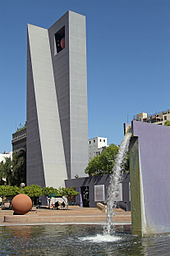Pershing Square (Los Angeles)
| Pershing Square | |
|---|---|
| La Plaza Abaja | |
City of Los Angeles | |
| Status | open |
| Website | www |
Pershing Square is a small public park in
History
19th century
In the 1850s, the location was used as a camp by settlers from outside the
In 1867, St. Vincent's College, present-day Loyola Marymount University, was situated across the street, and so the park informally became known as St. Vincent's Park. In 1870, it was officially named Los Angeles Park. In 1886 it was renamed 6th Street Park, and it redesigned with an "official park plan" by Frederick Eaton.[3] In the early 1890s it was renamed Central Park. During this period a bandstand pavilion was added for concerts and orators. The plantings became sub-tropically lush, and the park became a shady oasis and an outdoor destination. In 1894 the park was used as the staging area for the annual crowning of the queen of 'La Fiesta de Los Angeles.[2]
Early 20th century


A monument to California's twenty Spanish–American War dead was erected in 1900; it is said to be modeled after a Spanish–American War veteran, 7th California Infantry volunteer Charlie Hammond of San Francisco, and it is believed to be the oldest work of public art in Los Angeles. The Los Angeles City Council declared it a historic-cultural monument in 1990.[2]
In 1910 the park was renovated under a design by
In the 1920s and 1930s tropical plants were added to the park. In 1924, a life-size bronze of a World War I doughboy, sculpted by Humberton Pedretti, was unveiled, flanked by old cannons. In 1935, a bronze cannon from the USS Constitution was added.
In 1932, a
Later 20th century
The park was in heavy use during
Many of the palm trees that were excavated in the 1950s were sent to be used in the Disneyland ride The Jungle Cruise.[5]
The entire park was demolished and excavated in 1952 to build a three-level underground
The park continued to be neglected for safe uses. Its problems were noted during the 1960 Democratic National Convention, with nominee and future president John F. Kennedy headquartered at the Biltmore Hotel facing the park. By the 1984 Summer Olympics the park had become a serious eyesore, leading the city to spend $1 million for a temporary renovation.[2]
In 1992, the park was closed for a major $14.5-million redesign and renovation by Mexican architect and landscape architect Ricardo Legorreta and U.S. landscape architect Laurie Olin. The redesigned park opened in 1994 with a 10-story purple bell tower, fountains, and a walkway representing an earthquake fault line (by artist Barbara McCarren), concert stage, and perimeter seating. Pavement covered almost the entire block, with copses of trees placed in raised planters.[2] In 1994, the park was featured in Visiting... with Huell Howser Episode 208.[7]
21st century
In 2000, a monument was installed to honor local veteran Eugene A. Obregon.[8]

Pershing Square regularly hosts seasonal events such as a temporary Ice rink in the winter and DTLA Proud Festival[9] and live concert performances in the summer.
Public art
Permanent and temporary public art has been placed in Pershing Square since 1900, beginning with Los Angeles' oldest public art sculpture, the Spanish American War Memorial.[10]
- Spanish–American War Memorial (1900)
- The Doughboy (1924)
- Statue of Ludwig van Beethoven (1932)
- Neons for Pershing Square (1993) [transit station art below Pershing Square][11]
- Liquid Shard (temporary installation) (August, 2016)
Transit
The area is served by the
lines.See also
- List of parks in Los Angeles
- Liquid Shard, a 2016 art installation placed in Pershing Square
- DTLA Proud Festival
Further reading
- Chester Himes (March 22, 2000). "Lunching at the Ritzmore", The Collected Stories of Chester Himes, Da Capo Press. (Set in Pershing Square)
References
- ^ Masters, Nathan (2014-04-29). "L.A.'s Oldest Parks Began as Swamps and Other "Worthless" Lands". Gizmodo. Retrieved 2024-03-31.
- ^ a b c d e f g h Cecilia Rasmussen, The (d)evolution of a downtown landmark, Los Angeles Times, August 18, 2007.
- ^ "Pershing Square". Los Angeles Department of Recreation and Parks. Retrieved April 18, 2017.
- ^
Sunset Travel Guide to Southern California. Menlo Park, Calif.: Lane Publishing Co. 1974. p. 16. SBN 376-06754-3.
- ^ "Pershing Square Park". Los Angeles Times. Retrieved 15 February 2012.
- ^ Christopher Hawthorne (March 2, 2013), Los Angeles' major public spaces remain broken works in progress Los Angeles Times.
- ^ "Pershing Square Dedication-Visiting (208) – Huell Howser Archives at Chapman University".
- ^ Veterans Win OK of Statue to Honor Latino War Hero - Los Angeles Times. accessed 7/27/2010
- ^ "About".
- ^ Denger, Mark J. "The Spanish American War Memorial". Military Museum. Retrieved 13 September 2020.
- ^ "Neons for Pershing Square – Art".
External links
- "Pershing Square search results". Los Angeles Public Library.
- Wallach, Ruth (February 2000). "Historic Pershing Square, Los Angeles". University of Southern California Libraries, Public Art in Los Angeles.
- Holland, Gale (25 October 2012). "Pershing Square vision? Not so good". Los Angeles Times.
- Image of statue of Ludwig van Beethoven in Pershing Square on the day of its unveiling, Los Angeles, 1932-1939. Los Angeles Times Photographic Archive (Collection 1429). UCLA Library Special Collections, Charles E. Young Research Library, University of California, Los Angeles.

